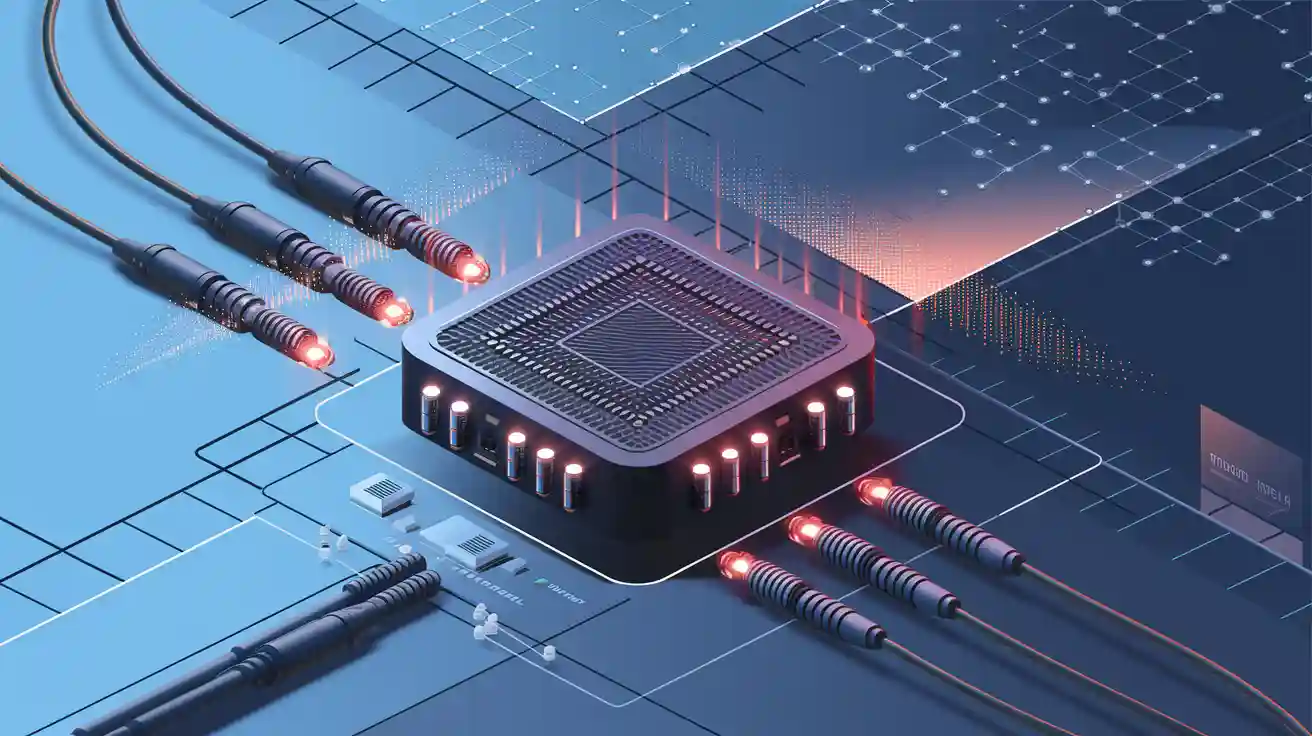Understanding the Standard and LINK-PP’s Optical Module Solutions

As mobile networks evolve from 4G to 5G, the infrastructure supporting them must become faster, more scalable, and more efficient. One of the key technologies enabling this transformation is the Common Public Radio Interface (CPRI) — a standardized interface that connects the baseband processing unit and the remote radio hardware in wireless networks.
In this blog post, we’ll explore what CPRI is, how it compares with eCPRI, the key technical terms involved, and how LINK-PP’s optical transceivers help power next-generation mobile networks.
What Is CPRI?
CPRI (Common Public Radio Interface) is a high-speed digital serial communication protocol that defines the interface between:
BBU (Baseband Unit) – Handles digital baseband processing
RRU / RRH (Remote Radio Unit / Remote Radio Head) – Manages radio signal transmission and reception at the cell site
The main purpose of CPRI is to allow separation between the radio hardware and baseband processing. This enables flexible deployment, such as locating BBUs in centralized locations (C-RAN) while placing RRUs near antennas on towers or rooftops.
CPRI fronthaul links are generally deployed over single-mode fiber using optical transceivers (such as SFP or SFP+), enabling high-throughput, low-latency communication. While certain enhanced optical modules can support distances of up to 40 km or more, standard deployments typically operate within 10–20 km, depending on transceiver type, fiber attenuation, and signal integrity constraints.
How CPRI Works
Architecture and Components
The architecture of CPRI (Common Public Radio Interface) is designed to establish a high-speed connection between baseband units and remote radio units. It follows a layered structure that ensures efficient communication and synchronization. Each layer plays a specific role in maintaining the integrity of the communication link.
Component/Layer | Description |
|---|---|
CPRI Specification | Defines the interface between baseband units (BBUs) and remote radio units (RRUs). |
Layer 1 | Supports electrical and optical interfaces, addressing time division multiplexing (TDM). |
Layer 2 | Provides flexibility and scalability for the communication link. |
Sync Module | Manages synchronization for frame and time alignments. |
Topologies | Supports point-to-point, star, ring, and daisy chain configurations. |
The baseband units process and manage baseband signals, while the remote radio units handle radio frequency signals. These components connect through the CPRI link, ensuring seamless data exchange. A synchronization module ensures precise timing, which is critical for maintaining high-speed data transmission. This architecture supports various topologies, allowing you to adapt the system to different network requirements.
Transmission Methods
CPRI uses a dedicated transmission method to transport data between BBUs and RRUs. This method relies on a continuous stream of time-domain samples, ensuring minimal latency. However, it also demands significant bandwidth. For example:
In a typical 2×2 MIMO LTE configuration with 20 MHz bandwidth, the corresponding CPRI line rate can reach approximately 2.4576 Gbit/s. This high rate accounts for continuous time-domain IQ sample transmission, which includes control and reference signals, not just user data. While the effective user throughput may be around 150 Mbit/s in certain small-cell deployments, this does not imply inefficiency in protocol design—rather, it reflects the strict real-time and high-fidelity transmission requirements of RF signals over CPRI.
CPRI's reliance on dedicated links for each data stream can make scaling costly, especially as mobile technologies advance. Enhanced CPRI (eCPRI) addresses this issue by adopting a packet-based approach. This method sends only the necessary data, optimizing bandwidth usage and reducing costs. While traditional CPRI excels in providing a reliable high-speed connection, its efficiency diminishes as data demands grow.
Role in Fronthaul Networks
In fronthaul networks, CPRI serves as the backbone for communication between the radio unit (RU) and the distributed unit (DU). It facilitates the exchange of user data, control signals, and synchronization information.
Finding | Description |
|---|---|
CPRI's Role | CPRI serves as the principal signal link between the RU and DU, facilitating the exchange of various data types. |
Compatibility Issues | Vendor-specific components in CPRI lead to interoperability challenges across different systems. |
Bandwidth Requirements | The high bandwidth demands of CPRI become problematic as 5G speeds increase, necessitating a shift to more flexible interfaces. |
Fronthaul Transport | The transport frame length in bits increases with bandwidth, affecting synchronization and service level agreements. |
Continuous Transport | Continuous transport of time-domain samples limits statistical multiplexing gains, impacting network efficiency. |
While CPRI has been instrumental in enabling high-speed data transmission, its limitations become evident in 5G networks. The high bandwidth requirements and vendor-specific designs create challenges for interoperability and scalability. As a result, many networks are transitioning to enhanced CPRI or other flexible interfaces to meet the demands of modern telecommunications.
Advantages of CPRI
CPRI has demonstrated its effectiveness in multiple generations of wireless networks. Its main advantages include:
Flexible and Scalable Architecture: CPRI supports varied base station configurations, from macro cells to distributed small cells.
CPRI provides a standardized protocol that aims to facilitate integration between baseband units (BBUs) and remote radio units (RRUs). However, due to vendor-specific implementations and version differences, real-world interoperability can be limited. In multi-vendor deployments, differences in line rates, control signaling, and CPRI option support may necessitate careful compatibility validation or customized engineering workarounds.
Wide Product Ecosystem: The standard enables a broad selection of compatible base station components and transceivers.
Open and Free Access: CPRI specifications are publicly available and open for contribution, fostering industry-wide innovation.
Supports Multiple Wireless Standards: Including GSM, WCDMA, LTE, and even early 5G.
Community-Informed Development: Anyone can propose updates, ensuring the standard evolves with market needs.
Together, these features make CPRI a proven and trusted interface standard in the global telecom infrastructure.
What Is eCPRI?
As mobile networks shift toward cloud-native and virtualized architectures like C-RAN and vRAN, a more advanced interface is required. That’s where eCPRI (Enhanced CPRI) comes in.
eCPRI introduces a more flexible, Ethernet-based fronthaul architecture that significantly improves bandwidth efficiency and supports advanced 5G features like network slicing and cloud-native radio access networks (C-RAN/vRAN). However, this flexibility comes with technical trade-offs: eCPRI relies heavily on precise time synchronization (often through IEEE 1588v2 PTP), and it must maintain low latency and jitter over shared transport networks. Ensuring deterministic performance on packet-based infrastructure remains a deployment challenge.
🔁 Comparison: CPRI vs eCPRI
Feature | CPRI | eCPRI |
|---|---|---|
Transport Medium | Serial optical fiber | Ethernet/IP (10G/25G Ethernet) |
Bandwidth Efficiency | Lower (transmits all data) | Higher (transmits only necessary data) |
Network Slicing | ❌ Not supported | ✅ Fully supported |
Cloud / Virtual RAN Ready | ❌ Limited | ✅ Optimized for C-RAN/vRAN |
Typical Use Case | 4G LTE, early 5G | Advanced 5G & disaggregated RAN |
eCPRI is tailored for modern 5G deployments that require dynamic resource allocation, network slicing, and greater integration with virtualized networks.
Key Terms Explained
BBU (Baseband Unit): Centralized unit that handles signal processing, modulation/demodulation, and data conversion.
RRU (Remote Radio Unit): Field-deployed radio head connected via fronthaul to the BBU; handles antenna signals.
REC (Radio Equipment Control): Another term for BBU.
RE (Radio Equipment): Another term for RRU.
Fronthaul: The transmission path between BBUs and RRUs using optical fiber and transceivers.
CPRI 7.0: The latest version of the CPRI standard, offering improved synchronization and higher data rates to support 5G.
Network Slicing: A method to divide network resources into multiple virtual networks, enabling customized services per user or application.
LINK-PP Optical Modules for CPRI and eCPRI
To meet the bandwidth and latency demands of mobile fronthaul, LINK-PP offers a comprehensive range of optical transceivers that support both CPRI and eCPRI protocols. These modules deliver the performance, stability, and durability required for high-demand telecom environments.
🔍 Featured Product: LS-CW3110-40I
Specifications:
Data Rate: 10 Gbps
Transmission Distance: Up to 40 km over SMF
Protocol Support: SFP+ MSA, CPRI, eCPRI, SFF-8431, SFF-8472, RoHS, ITU-T G.652
Temperature Range: -40°C to +85°C (Industrial-grade)
Form Factor: SFP+
Ideal for:
BBU–RRU fronthaul links
Centralized RAN (C-RAN) architectures
Long-distance metro fiber deployments
FAQ
What is the main purpose of CPRI?
CPRI connects baseband units (BBUs) to remote radio units (RRUs). It ensures high-speed, low-latency communication in wireless networks, especially for 4G and 5G technologies.
How does CPRI differ from eCPRI?
CPRI uses dedicated links for data transmission, while eCPRI adopts a packet-based approach. eCPRI optimizes bandwidth and supports virtualized architectures, making it ideal for 5G networks.
Can CPRI support future 5G requirements?
Yes, but with limitations. Enhanced CPRI (eCPRI) offers better scalability and efficiency, addressing the high-speed and low-latency demands of 5G networks.
Tip: Consider upgrading to eCPRI for a cost-effective and future-proof solution for 5G deployments.
See Also
Join Us in the Exciting LINK-PP Community Today
Understanding PCBA: The Core Component of Today's Electronics


